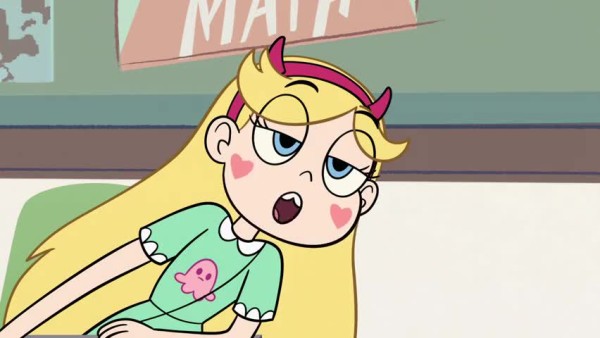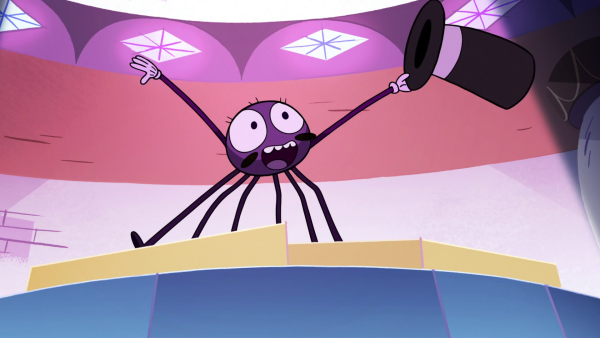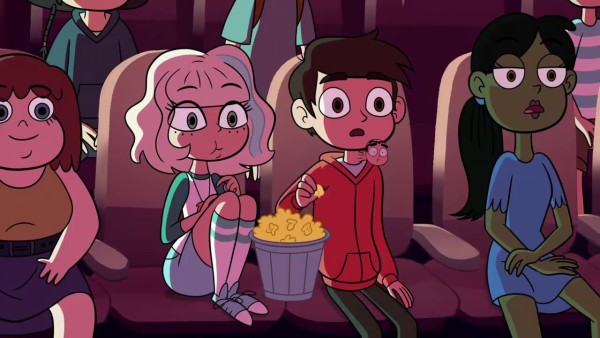
There’s an episode in the second season of Star Vs. The Forces of Evil called “Trickstar.” Weird Al Yankovic voices a creepy magician named Preston Change-O, who is invited to the birthday party of Marco’s sensei (at this point in the series, Marco and his sensei are friends for some reason. I’ll get into this in a bit.) Star, she of the magical propensity from the alternate world of Mewni, vaguely recognizes Preston and begins to suspect that something is off about him. Indeed, when Preston performs a magic trick, and his audience cheers, Preston sucks up the energy from their enthusiasm. He literally sucks in their “joy,” and his hat grows longer. It’s kind of a ridiculous visual. Anyway, Star recognizes this danger and tries to warn everyone, but those around her deem her a spoilsport – someone who’s trying to steal all the attention from the sensei’s festivities. Ironically, the episode does purport that Preston’s joy-stealing is, at worst, just a small annoyance: no one is deeply affected when their joy is snatched, and Star’s obsession does make her seem overzealous (the episode never quite expounds on what exactly this “joy” is, undercutting the plot; I’ll get into that deconstruction later). Well, no one is affected but Jeremy, whose joy seems like it’s completely gone, and is left sitting on the sidewalk as an ultra-depressed husk. The show posits Jeremy as kind of a joyless loser, but not the kind whose captured happiness seems warranted. Jeremy is all but rendered useless, but other than that “Trickstar” tries to be clever and undercut a common animation plot trope (with… another plot trope?). It doesn’t quite work.
Star Vs. The Forces of Evil has had a hell of a second season. The first one was a fun, wacky romp of adventures and insanity, with a John K. sensibility that overcame the weaknesses of some of the characterizations (most notably in Marco’s friends, who are rarely seen in the second season). The show’s sophomore run toned down the abject silliness a lot, opting for something a vibe that is split between Steven Universe and Adventure Time; the aesthetics are more grounded, measured, and methodical. It’s a pretty notable shift, and it’s a shift that’s not just regulated to the animation. The characters are more… well, I don’t want to say mature, but they are more distinct, more complex in a way that suggests the writers are pursuing long term development for its cast. What makes that stand out, however, is in order to do that, Star Vs. has decided to travel down some insanely odd, unusual, unconventional narrative paths to get there.
I think about that “Trickstar” episode a lot; it’s such a good example of what the show seems to be trying to do, and yet, stumbles on at times. I think the idea of subverting the narrative trope of a figure who sucks some kind of “essence” from people is worthy of doing, but I question the end result when, essentially, one character is effectively destroyed by it, and the weird, tonally off, ambivalent/ambiguous/indifferent theme of the entire episode (let’s be clear: Preston is stealing something from people, and whether or not it’s “harmless” is besides the point – it never was his to take). Star Vs. is clearly eager to subvert and/or deconstruct the kinds of episodes we have come to expect in our animated series. I don’t think it does a great job; or, more accurately, I don’t think it has quite a handle on the full extent on the narratives it tries to subvert or deconstruct (certainly not to the extent that Gumball does, which understand its tropes in minute detail so that its subversions/deconstructions work beautifully).

Take “Spider with a Top Hat,” a wildly off-beat episode in which we explore the lives of the very strange, whimsical animals that zap forth from Star’s wand. The creatures spend their lives within Star’s wand like a TARDIS, prepping their existence in order to do battle when summoned; a hapless, cheerful spider at the center plays the role of moral support for these magical warriors. The spider is also pining for his chance to be summoned into battle as well, even though he can barely break a wall with his head. This…. all works better in context, its baffling premise making more sense on the animated screen. It’s a narrative that’s certainly unexpected, but waddles into laziness when the spider, upon being summoned in desperation during a viciously tense battle, suddenly deploys a gattling gun from underneath his top hat. It’s a sudden, throwaway climax to a unique story with a unique premise: the kind of answer you’d find in a notebook of a eight grade boy. “He had a BADASS gun inside him all along” is flat storytelling.
That’s the kind of episode development that hints at Star Vs.’s core issue. It’s second season truly seeks to tell very unique, very audacious stories, but in many ways struggle to push that desire into something meaningful or perceptive. All of the crazy, wild narrative beats and questionable characters are put in place to throw audience expectations askew, but it’s clear that’s just all the writers want to do. The main thematic thrust is about insecurity, mainly centered around a jealousy Star develops when Marco and Jackie (a typical bland, “chill” female character) begin a relationship. Insecurity is part of most, if not all, the episodes of the season, and you can make the raw argument that these off-kilter storylines are meant to instill a level of discomfort and awkwardness in the viewers as well – you’re supposed to feel uncomfortable from the “incompleteness” of an episode, to best reflect the uncomfortableness felt buy all the characters, their relationships, and what they’re all going through.
It’s extremely tough for me to buy, though, as some of the decisions feel less like a bid for thematic resonance, or connections towards insecurity and discomfort, and more just narrative curveballs for the sake of them – both in characterizations and it storytelling choices. For example, Star Vs. opted to lean on an assortment of new characters defined by a “quirk” that’s less “pixie” and more “disturbing”. The first episode introduces a women who collects hair; when she admits this, there’s a music cue that indicates danger. But she’s anything but: she in fact helps Star through her predicament. Which is fine, within the broad, generic lesson of not judging books by their covers. The overall impact of her appearance is moot, though: other than a reference to this woman and her weird hobby later in the season, she feels like a waste of a unique character. Other weird characters include a dog suffering with depression, a insecure being with talking snakes for arms (who gets in way over his head), and a former Mewni warrior turned homeless-sociopath on Earth. Each character is unmistakably distinct, but they never leave a lasting impression. What purpose do they serve, particularly in a season clearly working its way towards a bigger, grander arc? Even recurring characters feel formless. I somewhat can abide by Tom and his anger issues, but he functions better as a toxic, masculine obstacle to Star than jerky man-friend to Marco. I can’t say the same for Marco’s sensei, whose friendship makes less sense than Marco’s original first season friends – at least they were in the same grade as him. Marco’s sensei is a pathetic manbaby who more or less guilts Marco into befriending him, which in and of itself is a pretty toxic event.
And sometimes, I think the show misunderstands the difference between insecurity and personal secrets. “Naysayer” involves a curse that’s supposed to get Marco to admit his deepest secrets, but the episode ties them to his insecurity, and fails to realize they’re completely different. Nervousness in asking a girl out – and the hundreds of reasons that one conjures up that would prevent said girl from returning the affection – is the key to Marco’s insecurity. “Naysayer” forces Marco to just say a bunch of weird personal stuff that he does. I get that the show is trying to tie those personal behaviors to his fear of asking Jackie out, but since we’re not clear on what specifically about himself and those behaviors that worries him in relation to Jackie, it comes off completely the opposite of what the scene probably intended. (You try telling someone you barely know all the weird shit that you do out of the blue.) But since Jackie is barely a character, she’s totally cool with it all.

This is, in some ways, a manifestation of an issue that bogged down the first season: Marco receives quite a bit of screen time for a show ostensibly titled Star Vs. the Forces of Evil. And it’s not as if Marco is a bad character. He’s clearly an important one as well. But Star’s conflict, whose personal sensibilities and attitudes butt up against Mewni’s expectations and historical legacies, is a juicier, meatier narrative than anything to do with Marco. While I admire the second season’s attempt to blend her conflict with the emotional struggle Star is going through upon learning of Marco and Jackie’s romance, it still remains at odds. It feels like a narrative step back from the lesson she learned in “Sleepover,” where crushes and desires ebb and flow overtime, but it also feels like a secondary conflict forced to the surface over the more intriguing narrative of the bizarre Mewni situation involved Ludo, Bullfrog, the return of Toffee, Glosseryk, and Star’s own mother. Also, to be blunt, the narrative building of this conflict comes off incomplete, a smorgasbord of mediocre, world-building, wheel-spinning that, to me, signifies a backstory that’s still being worked on. Nothing that occurred this season seems meaningful, important, or intriguing enough to follow. The reveal in first season’s “Mewnipendence Day” – that Mewni was most likely the aggressive force that subsumed the more innocent, native monsters – feels more worthwhile than the vague information that dripped out during the course of the season.
Looking back over that second season, eyeing episode descriptions while re-watching select ones, I admit that despite my criticisms, my curiosity is still piqued. Yet it’s not for a real desire to learn the secrets and truths of the world and history of this Mewni/Earth setting (and the characters that inhabit it), but more for the sake of relief – an assurance that the creative team does, in fact, have a real long-term arc ahead of them. I’ll swallow up Star’s personal feelings and heartache if that struggle is dealt with in strong collaboration with the greater conflicts and reveals that will emerge from what Ludo, Toffee, Glosseryk, and the entire Butterfly family holds. What do we know at this point, in terms of the overall story? We learn that Star is extremely powerful, which would have been better served to learn as we see Star’s power grow (we don’t really see this). We learn someone is “draining all the magic” in “Page Turner,” which is just a nebulous statement – why should be concerned about this? And by the season finale, we learn that Toffee is back, which is cool (Toffee was one of season one’s greatest characters), but we don’t know what this means.
And yet, I don’t think that the second season of Star Vs. is bad, per se. A lot of it is great, and interesting, and just weird enough to keep paying attention to, and it’s worth at the very least talking about, way more than any potential Marco/Star ships. I do think that, in its desire to be part of the pantheon of great cartoons like Gravity Falls, Gumball, Adventure Time, and Steven Universe, it sought depth and irony and deconstruction and subversions, but it all amounts to blank slates and purposely confusing oddities; its weirdness is the animated version of what Matthew Christman describes as (animated) TV becoming respectable without getting better. For all it’s faults, I do respect the hell out of Star Vs. The Forces of Evil, and maybe its third season premiere will tie this all together in some significant way. But it’s desire to be a game-changer makes the entire season seem like work: I can feel the effort and strain behind it to be “talked about.” What I don’t feel is the one thing that Star herself would want to be: fun.
Comments are closed